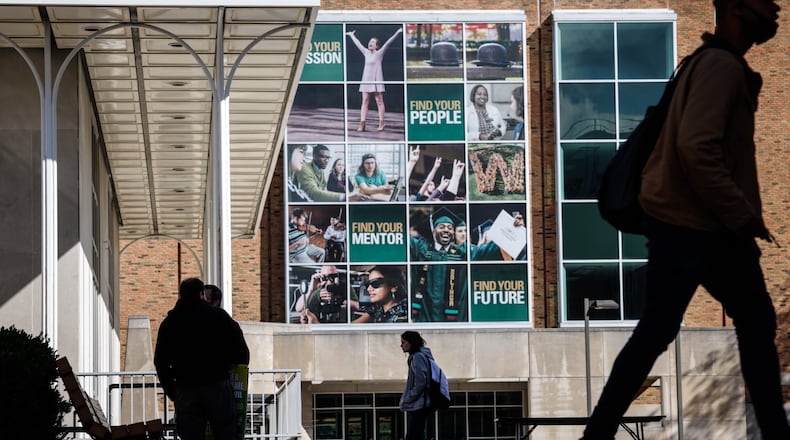“Enrollments are not getting better,” said Doug Shapiro, executive director of the National Student Clearinghouse Research Center. “They’re still getting worse.”
In this region, fall semester enrollment is a mixed bag. Wright State and Wittenberg are reporting down student enrollment on their campuses, while University of Dayton, Miami and Cedarville are reporting small increases.
There was simply no upside from the recession,” Shapiro said. “Just a downside that we’re seeing now from the recovery in the in the job market.”
Graduate student enrollment increased this semester in the US, according to the research the center has done, rising 2.1% above last year’s level, for a total increase of 5.3% over two years.
Community colleges remain the most affected sector, experiencing a 14.1% total US enrollment decline since fall 2019, Shapiro said.
However, some local community colleges said they did not see the great declines that community colleges nationwide did. Clark State College reported it had an increase of about 1% in enrolled students this year compared to last fall.
Sinclair Community College said its initial enrollment is down about 2% compared to 16,304 in fall 2020. However, Cathy Petersen, a spokesman for Sinclair, said the college expects to continue to enroll students and expect to have about 18,000 students enroll in fall 2021.
Sinclair has worked with students to help them stay in school during the pandemic, Peterson noted.
“Throughout the COVID-19 global pandemic, Sinclair adjusted its programs and expanded services to ensure students could safely achieve their college and career goals through quality, affordable education,” Petersen said.
But many US students are simply choosing not to go to community college. This year’s first-year class at community colleges is now 20.8% below 2019′s, while the first-year enrollment numbers at all institutions are 12.3% smaller than in 2019, the National Student Clearinghouse Research Center said.
Community colleges historically serve populations that come from lower incomes or are not white, and those populations seem to have left college, according to the same research.
Shapiro noted that some of these students seem to have been lured away, possibly into the labor market.
“These are the students who have always been the most on the margin between college and the workforce, and also the most powerfully pulled away by the need to support their families through hard times,” Shapiro said.
Credit: Jim Noelker
Credit: Jim Noelker
Among public four-year institutions, highly selective state flagships increased about 1% while less selective public saw enrollment fall by 5.2% overall, the National Student Clearinghouse Research Center said.
Ohio State University saw record high enrollment at the main campus this year in Columbus, but their overall enrollment was down by 0.7%, according to enrollment data from the university.
That’s because the satellite campuses, like the OSU Lima campus, saw declines. Notably, the Lima campus saw a decline in enrollment of 12.4% compared to fall 2020.
But problematically, first-year enrollment fell about 3.1% this fall. The rate of decline is less than autumn 2020′s 9.5% loss, but the numbers have not stabilized nor shown a level of increase required to restore the losses from 2020′s entering class, the National Student Clearinghouse Research Center said.
Public two-year institutions again showed the sharpest freshman enrollment declines among the three largest sectors at -6.1%, the National Student Clearinghouse Research Center said.
Jessica Rivinius, a spokesman for Miami University, said the college had its largest first-year class in history.
At the Oxford campus, enrollment of the first-year, incoming class, grew by nearly 18% to 4,519 students
“This growth is attributable to the strength of Miami’s programs and our commitment to undergraduate education, and our outcomes,” Rivinius said.
Area colleges up close
Here’s what local colleges and universities saw in their initial enrollment counts:
- Miami University reports 23,045 students are enrolled for fall semester, up about half a percent from last fall semester.
- University of Cincinnati reports 35,339 undergraduate students were enrolled for fall semester and a total of 46,710 students are enrolled overall. Last fall UC reported a preliminary enrollment of 46,798 students across all campuses.
- Cedarville University gained 3.6% more students than last fall.
- University of Dayton says it predicts a record-high enrollment of about 12,030 students, up about 3% from last fall.
- At Wright State, preliminary enrollment count fell by about 6% compared to 2020 preliminary numbers, with 11,469 students currently enrolled in the fall 2021 semester. However, the university says about 400 more students enrolled this fall than was expected. Wright State has seen enrollment fall for the last several years.
- Wittenberg University had 1,300 students enrolled as of Aug. 30, the first day of classes, down from 1,455 students in fall 2020.
About the Author


